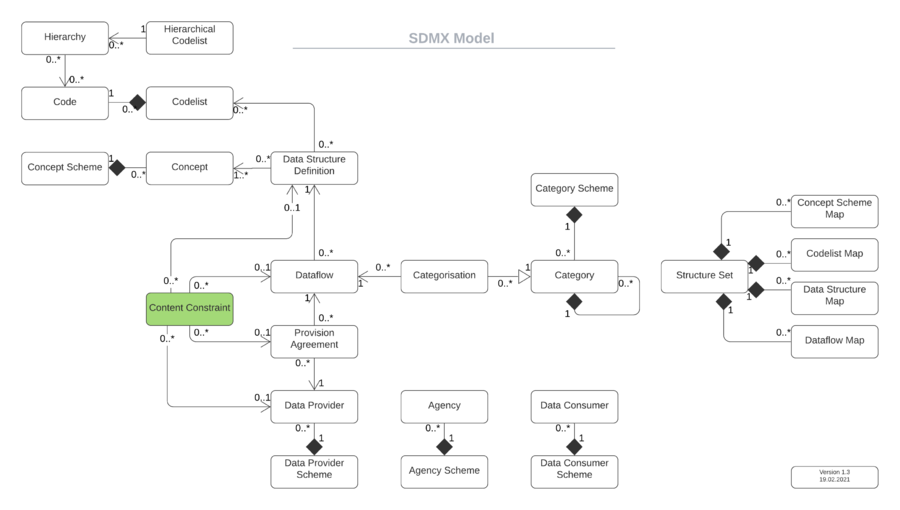Difference between revisions of "Content Constraint"
(→Usage) |
(→Usage) |
||
| Line 43: | Line 43: | ||
The attachable constraint is used to define “cube slices” which identify sub sets of data in terms of series keys or dimension values. The purpose of this is to enable 1metadata to be attached to the constraint, and thereby to the cube slices defined in the Constraint. The metadata can be attached via the “reference metadata” mechanism – MSD and Metadata Set – or via a Group in the DSD. | The attachable constraint is used to define “cube slices” which identify sub sets of data in terms of series keys or dimension values. The purpose of this is to enable 1metadata to be attached to the constraint, and thereby to the cube slices defined in the Constraint. The metadata can be attached via the “reference metadata” mechanism – MSD and Metadata Set – or via a Group in the DSD. | ||
| + | |||
| + | ===Rules for a Content Constraint=== | ||
==Conventions== | ==Conventions== | ||
Revision as of 05:45, 10 February 2021
Contents
Overview
Content Constraints define restrictions on Codelists or Series for Data Reporting.
Structure Properties
| Structure Type | Standard SDMX Structural Metadata Artefact |
|---|---|
| Maintainable | Yes |
| Identifiable | Yes |
| Item Scheme | No |
| SDMX Information Model Versions | 1.0, 2.0, 2.1 |
| URN - ConceptScheme namespace | urn:sdmx:org.sdmx.infomodel.conceptscheme.ConceptScheme |
| URN - concept namespace | urn:sdmx:org.sdmx.infomodel.concept.Concept |
Context within the SDMX 2.1 Information Model
The schematic illustrates the core artifacts of the SDMX 2.1 Information Model, and how Content Constraints fit in.
Usage
Constraints can be applied to Dataflows, Data Providers or Provision Agreements in order to restrict the data being validated or converted.
Note that regardless of the artifact to which the Constraint is associated, it is constraining the contents of code lists in the DSD to which the constrained object is related.
The Constraint can be of one of two types:
- Content constraint
- Attachable constraint
The attachable constraint is used to define “cube slices” which identify sub sets of data in terms of series keys or dimension values. The purpose of this is to enable 1metadata to be attached to the constraint, and thereby to the cube slices defined in the Constraint. The metadata can be attached via the “reference metadata” mechanism – MSD and Metadata Set – or via a Group in the DSD.
Rules for a Content Constraint
Conventions
Content Constraint IDs IDs are conventionally uppercase using underscores '_' as separators if required. Examples:
| Agency | Content Constraint ID | Constrained Structure | SDMX-ML |
|---|---|---|---|
| ESTAT | CR_HICP_AP_A | HICP_AP_A[2.0] | [ https://registry.sdmx.org/ws/public/sdmxapi/rest/contentconstraint/UIS/CR_EDUCAT_CLASS_A/1.0 SDMX-ML] |
| UIS | CR_EDUCAT_CLASS_A | EDUCAT_CLASS_A[1.0] | [ https://registry.sdmx.org/ws/public/sdmxapi/rest/contentconstraint/UIS/CR_EDUCAT_CLASS_A/1.0 SDMX-ML] |
| WB | GHA | GHA | [ https://demo.metadatatechnology.com/FusionRegistry/ws/public/sdmxapi/rest/contentconstraint/WB/GHA/1.0 SDMX-ML] |
You can seem more examples and information on Identities in this article.
